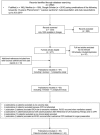Autoresuscitation (Lazarus phenomenon) after termination of cardiopulmonary resuscitation - a scoping review
- PMID: 32102671
- PMCID: PMC7045737
- DOI: 10.1186/s13049-019-0685-4
Autoresuscitation (Lazarus phenomenon) after termination of cardiopulmonary resuscitation - a scoping review
Abstract
Background: Autoresuscitation describes the return of spontaneous circulation after termination of resuscitation (TOR) following cardiac arrest (CA). We aimed to identify phenomena that may lead to autoresuscitation and to provide guidance to reduce the likelihood of it occurring.
Materials and methods: We conducted a literature search (Google Scholar, MEDLINE, PubMed) and a scoping review according to PRISMA-ScR guidelines of autoresuscitation cases where patients undergoing CPR recovered circulation spontaneously after TOR with the following criteria: 1) CA from any cause; 2) CPR for any length of time; 3) A point was reached when it was felt that the patient had died; 4) Staff declared the patient dead and stood back. No further interventions took place; 5) Later, vital signs were observed. 6) Vital signs were sustained for more than a few seconds, such that staff had to resume active care.
Results: Sixty-five patients with ROSC after TOR were identified in 53 articles (1982-2018), 18 (28%) made a full recovery.
Conclusions: Almost a third made a full recovery after autoresuscitation. The following reasons for and recommendations to avoid autoresuscitation can be proposed: 1) In asystole with no reversible causes, resuscitation efforts should be continued for at least 20 min; 2) CPR should not be abandoned immediately after unsuccessful defibrillation, as transient asystole can occur after defibrillation; 3) Excessive ventilation during CPR may cause hyperinflation and should be avoided; 4) In refractory CA, resuscitation should not be terminated in the presence of any potentially-treatable cardiac rhythm; 5) After TOR, the casualty should be observed continuously and ECG monitored for at least 10 min.
Keywords: Autoresuscitation; Cardiopulmonary resuscitation; Emergency medicine; Hyperventilation; Lazarus phenomenon; Resuscitation; Resuscitation orders.
Conflict of interest statement
The authors declare that they have no competing interests.
References
Publication types
MeSH terms
LinkOut - more resources
Full Text Sources
Medical


